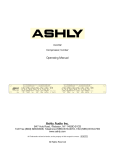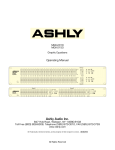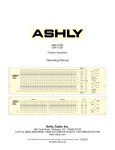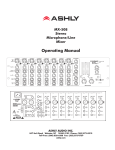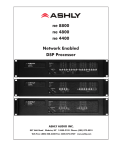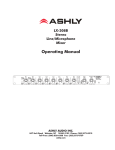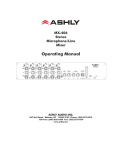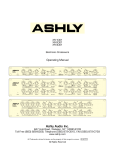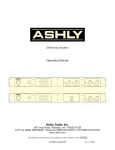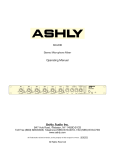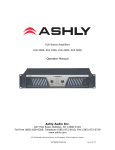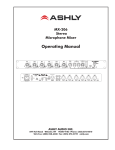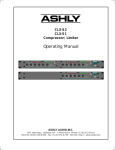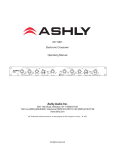Download Ashly CLX-52 Specifications
Transcript
CLX-52 Compressor/Limiter Operating Manual Ashly Audio Inc. 847 Holt Road, Webster, NY 14580-9103 Toll Free (800) 828-6308, Telephone (585) 872-0010, FAX (585) 872-0739 www.ashly.com All Trademarks referred to herein, are the property of their respective owners. R-1012 All Rights Reserved Page - 2 Operator Manual – CLX-52 Compressor/Limiter This Page Intentionally Left Blank Page 3 Operator Manual – CLX-52 Compressor/Limiter Important Safety Instructions Consignes de sécurité à lire attentivement The lightning flash with arrowhead symbol, within an equilateral triangle, is intended to alert the user to the presence of uninsulated "dangerous voltage" within the product's enclosure that may be of sufficient magnitude to constitute a risk of electric shock to persons. The exclamation point within an equilateral triangle is intended to alert the user to the presence of important operating and maintenance instructions in the literature accompanying the device 1. Read these instructions. 2. Keep these instructions. 3. Heed all warnings. 4. Follow all instructions. 5. To reduce the risk of fire or electric shock, do not expose this apparatus to rain or moisture. 6. Do not use this apparatus near water. 7. Clean only with dry cloth. 8. Do not block any ventilation openings. Install in accordance with the manufacturer’s instructions. 9. Do not install near any heat sources such as radiators, heat registers, stoves, or other apparatus (including amplifiers) that produce heat. 10. Do not defeat the safety purpose of the polarized or grounding-type plug. A polarized plug has two blades with one wider than the other. A grounding type plug has two blades and a third grounding prong. The wide blade or the third prong are provided for your safety. If the provided plug does not fit into your outlet, consult an electrician for replacement of the obsolete outlet. 11. Protect the power cord from being walked on or pinched particularly at plugs, convenience receptacles, and the point where they exit from the apparatus. 12. Only use attachments/accessories specified by the manufacturer. 13. Use only with the cart, stand, tripod, bracket, or table specified by the manufacturer, or sold with the apparatus. When a cart is used, use caution when moving the cart/apparatus combination to avoid injury from tip-over. 14. Unplug this apparatus during lightning storms or when unused for long periods of time. 15. Refer all servicing to qualified service personnel. Servicing is required when the apparatus has been damaged in any way, such as power-supply cord or plug is damaged, liquid has been spilled or objects have fallen into the apparatus, the apparatus has been exposed to rain or moisture, does not operate normally, or has been dropped. Le symbole de la flèche dans un triangle équilateral symbolisant la foudre est prévu pour sensibiliser l’utilisateur à la présence de tension de voltage non isolée à l’intérieur de l’appareil. Elle pourrait constituer un danger de risque de décharge électrique pour les utilisateurs. Le point d’exclamation dans le triangle équilatérale alerte l’utilisateur de la présence de consignes qu’il doit d’abord consulter avant d’utiliser l’appareil. 1. Lisez ces instructions. 2. Conservez ces instructions. 3. Observez les avertissements. 4. Suivez ces instructions. 5. Pour réduire le risque de feu ou la décharge électrique, ne pas exposer cet appareil pour pleuvoir ou l'humidité. 6. Ne pas utiliser l’appareil près de l’eau. 7. Le nettoyer à l’aide d’un tissus sec. 8. Ne pas bloquer les ouvertures de ventilation, installer selon les consignes du fabricant. 9. Eloigner des sources de chaleur tel: radiateurs, fourneaux ou autres appareils qui produisent de la chaleur. 10. Ne pas modifier ou amputer le système de la mise à terre. Une prise avec mise à terre comprend deux lames dont une plus large ainsi qu’une mise à terre: ne pas la couper ou la modifier. Si la prise murale n’accepte pas la fiche, consulter un électricien pour qu’il remplace la prise désuète. 11. Protéger le cordon de secteur contre tous bris ou pincement qui pourraient l’endommager, soit à la fiche murale ou à l’appareil. 12. N’employer que les accessoires recommandés par le fabricant. 13. N’utiliser qu’avec les systèmes de fixation,chariots, trépied ou autres, approuvés par le fabricant ou vendus avec l’appareil. 14. Débrancher l’appareil lors des orages électriques ou si inutilisé pendant une longue période de temps. 15. Un entretient effectué par un centre de service accrédité est exigé si l’appareil a été endommagé de quelque façon: si il a été exposé à la pluie,, l’humidité ou s’il ne fonctionne pas normalement ou qu’il a été échappé. FCC Compliance This device complies with part 15 of the FCC Rules. Operation is subject to the following two conditions: 1. This device may not cause harmful interference 2. This device must accept any interference received, including interference that may cause undesired operation Note: This equipment has been tested and found to comply with the limits for a Class B digital device, pursuant to part 15 of the FCC Rules. These limits are designed to provide reasonable protection against harmful interference in both a commercial and residential installation. This equipment generates, uses and can radiate radio frequency energy and, if not installed and used in accordance with the instructions, may cause harmful interference to radio communications. However, there is no guarantee that interference will not occur in a particular installation. If this equipment does cause harmful interference to radio or television reception, which can be determined by turning the equipment off and on, the user is encouraged to try to correct the interference by one or more of the following measures: - Reorient or relocate the receiving antenna. - Increase the separation between the equipment and receiver. - Connect the equipment into an outlet on a circuit different from that to which the receiver is connected. - Consult the dealer or an experienced radio/TV technician for help. All Rights Reserved Page - 4 Introduction - 4 About Ashly Safety CLX-52 – 5 Connectors & Cables – 5 Physical Description - 6 Installation – 7 Typical Applications - 8 Troubleshooting - 9 Dimensions - 9 Specifications - 10 Warranty - 11 Operator Manual – CLX-52 Compressor/Limiter Introduction Congratulations on your purchase of an Ashly CLX-52 Peak Compressor/Limiter. The CLX-52 was designed to meet the need for universal peak-sensitive automatic gain control (AGC) devices with exceptional audio performance and rugged durability. The CLX-52 has the following key features: Threshold Control Input/output meter with select switch Balanced XLR connectors ¼” Phone jack connectors Euroblock connectors A single TRS patch point detector loop Premium components throughout Worldwide Power Supply We are confident that you will be pleased with the high performance, superb sound quality, and reliability that Ashly is known for. About Ashly This manual uses a Perpetual Table Of Contents. Each page has a copy of the manual’s contents in a gray box just like this one. The section you are in will always be bold with the other sections “grayed out.” The feature allows you to jump directly to another section without having to return to a Table Of Contents page. Ashly Audio was founded in 1974 by a group of recording engineers, sound professionals, and electronics designers. The first products were custom consoles for friends and associates, but business quickly grew. The philosophy established from the very beginning holds true today: to offer only the highest quality audio tools at an affordable cost to the professional user – ensuring reliability and long life. More than thirty-five years later, Ashly remains committed to these principles. What Compressors and Limiters Do Limiting – All musical programs have constant changes in loudness. It is the job of a limiter to detect when the volume has exceeded a predetermined maximum safe level, and to then turn down the volume. When the incoming signal returns to its original level, the limiter should respond by restoring the gain to normal. Thus, when the level is within a specified “safe” range, the limiter has no effect. When an occasional peak occurs, the limiter responds. Compression - A significant difference in dynamic range is achieved simply by changing the relationship between nominal signal level and threshold, as a result of either increasing the GAIN and/or decreasing the THRESHOLD control. The most interesting effect to be noted, however, is seen by comparing the original input signal with the output signal. The quietest portions of the original signal will be effectively increased in volume while the loudest portions of the original signal will be decreased. In effect, both ends of the dynamic spectrum will be pushed toward the “middle”. More than anything else, it is this double-ended effect, which distinguishes compression from limiting. Copyright© 2012 – Ashly Audio Inc. Operator Manual – CLX-52 Compressor/Limiter CLX-52 Compressor/Limiter Page - 5 Introduction – 4 A great deal of time was spent developing a wide-bandwidth, ultra-low-distortion, low noise VCA (voltage controlled amplifier). The result is the CLX-52, a versatile and highly listenable compressor/limiter suitable for use in professional sound reinforcement, recording and broadcasting. The CLX-52 has three different connector types: 1/4” inch stereo TRS jacks Three pin XLR type connectors Euroblocks These three connectors facilitate interfacing to most professional audio products. Both inputs and outputs can be used balanced or unbalanced. Connectors & Cables Your CLX-52 Compressor/Limiter is provided with three different connector types: 1. 1/4 inch stereo phone jacks (TRS) 2. Three pin XLR type connectors 3. Euroblock screw terminal connectors When possible, balanced connections are recommend between all components in your system, as this eliminates ground-loop induced hum and noise. Unbalanced Connections and Grounding If you must use unbalanced connectors, the negative lead of the connector should be tied to the ground lead. Using unbalanced connections could result in chassis ground-loop noise. Altering the signal/chassis ground relationship in equipment connected to your GQX unit may eliminate the noise. All Rights Reserved CLX-52 – 5 Connectors & Cables – 5 Grounding Physical Description - 6 Installation – 7 Typical Applications - 8 Troubleshooting - 9 Dimensions - 9 Specifications - 10 Warranty - 11 Page - 6 Operator Manual – CLX-52 Compressor/Limiter Introduction - 4 CLX-52 – 5 Connectors & Cables – 5 Physical Description - 6 Front Panel Rear Panel Physical Description The CLX-52 is 1RU, and weighs eight pounds. CLX-52 Front Panel Installation – 7 Typical Applications - 8 Troubleshooting - 9 1. Dimensions - 9 Specifications - 10 Warranty - 11 2. 3. 4. 5. 6. Gain – The Gain control adjusts incoming signal level to the VCA circuit. It is always active, so switching out the limiter function has no effect on this control. This control should normally be left at "0" to achieve accurate Threshold calibration. Threshold - The Threshold control has a range of -40 to +22 dB, allowing applications from low level compression to high level limiting. The Threshold control determines the audio level above which Gain Reduction occurs. When the signal peaks exceed the selected threshold, the LED comes on and gain reduction is occurring. Ratio- This control determines the ratio of change in output level to changes in input level for signals above threshold. The numbers printed around the Ratio control are calibrated in db and indicate the increase in input (above threshold) required to produce a 1db increase in output. This can be expressed conveniently as a ratio. If the output remains constant no matter how high the input level, we have an infinite (∞) input/output ratio. It should be remembered that the Ratio control has no effect on signals which are below threshold. Attack Time - The response of the compressor/limiter to signal levels above threshold is further defined by the Attack Time control. Attack time is the amount of time that the unit takes to attenuate the output level after threshold has been reached. This unit provides continuously variable attack times from 200 microseconds to 20 milliseconds. Release Times - Release time, is the time required to restore system gain to normal after the input signal has fallen below threshold level. Proper release time will depend on the type of program material being processed and the way in which the limiter is being used. Output Level - Output Level control is provided to fully cut or restore up to 18 dB of system gain. For unity gain, set the control to 0 7. In/Out Switch - This switch enables you to quickly hear the CLX compressor/limiter in or out of the audio chain. When the switch is in the OUT position, all limiting and compression controls and functions are bypassed, with the exception of the Gain and Output controls, which continue to function. 8. Stereo Tie Switch - This switch allows for Gain Reduction on a stereo signal with no degradation of the stereo image. When pressed in, the Stereo Tie Switch combines each channel's internal detector outputs so that the channel with the loudest signal will determine the action applied to both channels. Leave this switch out for normal operation. 9. Threshold/Gain Reduction Display - As soon as the threshold level is reached, the yellow LED illuminates. Depending on how far the input level rises above threshold, successive red LED’s will illuminate, indicating gain reduction. Gain Reduction can best be described as the difference between input level and the resulting change to output level. For signals above threshold, output level will increase only to the extent that the ratio control allows. 10. Input/Output Meter Select - The While the Gain Reduction display accurately represents the action of the limiter, comparing input to output levels in real time is somewhat more intuitive, and is made simple using the Input/ Output Meter Select switch. The Input meter takes its signal just after the Gain control, and will indicate input signal level regardless of CLX output levels or limiter settings. The output meter display takes its signal from the actual output of the unit, so every control that affects the output will also have an effect on output meters. Used in conjunction with the gain reduction meters, Input/Output meters prove to be an extremely useful diagnostic tool when working with system dynamics and level control. A unique feature of Ashly Compressor/ Limiters is the incorporation of a double release-time constant. When a conventional compressor/limiter is adjusted for slow release times, transients such as mic “pops” may cause a severe reduction in gain followed by a slow fadeup, making the action of the limiter very obvious. With the double time constant, release from gain reduction after a brief transient is always fast, with a slower release after a sustained overdrive. Copyright© 2012 – Ashly Audio Inc. Operator Manual – CLX-52 Compressor/Limiter Page - 7 CLX-52 Rear Panel Introduction - 4 CLX-52 – 5 Connectors & Cables – 5 Physical Description - 6 1. 2. Inputs and Outputs - Your CLX-52 Compressor/Limiter is provided with three different connector types. 1/4" TRS (tip-ringsleeve) jacks, XLR connectors and Euroblocks. Inputs are 20KΩ active balanced using 1% metal film resistors, outputs are 132Ω servobalanced. Detector Loop - Ducking - The CLX-52 Compressor/Limiter has a TRS Insert 3. DETECTOR PATCH point which can be used as a "ducking" input, or in conjunction with an equalizer to produce frequency-sensitive limiting. Various uses of the detector patch are discussed under Typical Applications. Power – Switches the unit power on or off Installation Use four screws and paint-piercing washers when rack mounting the CLX-52. For mobile use, the unit should be further secured as appropriate. General Requirements The CLX-52 has specific physical, electrical and signal requirements for proper operation. These requirements will vary depending on your specific application, setup, and the settings on the unit. When setting up and testing your system, please take special care to double check all connections and settings. Please refer to the specifications section of this manual for specific input, output and other figures. AC Power Your CLX-52 should be connected to a standard 3-wire grounded electrical outlet supplying 100-240 Volts, 50-60 Hz. To reduce the risk of ground loop hum, connect all audio equipment to the same electrical power source. Do not remove the AC plug ground pin, as a potential shock hazard could result. This unit will perform normally within the AC voltage range specified above. Voltages less than this, as found in “brown-out” conditions, may reduce performance. No user serviceable parts are inside the chassis. Refer all servicing to qualified service personnel. Overall power consumption is less than 30 watts. NOTE: The power switch does NOT isolate the appliance from mains. Make sure the mains power socket or an alternative disconnect device is near by and easily accessible. When the product is connected to mains, the line-filter and the input of the fuse are energized. All Rights Reserved Installation – 7 General Requirements AC Power Typical Applications - 8 Troubleshooting - 9 Dimensions - 9 Specifications - 10 Warranty - 10 Page - 8 Introduction - 4 GQX Equalizers – 5 Connectors & Cables – 5 Physical Description - 6 Installation – 7 Typical Applications - 8 Protective Device Recording De-Essing Instrument Texture De-Essing Troubleshooting - 9 Dimensions - 9 Operator Manual – CLX-52 Compressor/Limiter Typical Applications The applications of the Ashly CLX-52 can be divided into two basic categories, limiting and compressing. When used as a protective device, it is functioning as a Limiter. It may also be used to reduce the dynamic range of a signal, creating a fuller sounding signal without increasing the loudness peaks, in which case it is functioning as a compressor. The CLX-52 As A Protective Device The CLX-52 provides fast and accurate gain control for the prevention of sound system overload due to unexpected transients. Sustained distortion caused by amplifiers running out of power or occasional, one-shot high level overload (a microphone falling onto a hardwood floor) can damage speakers and other system components. The CLX-52 can be installed in several locations in a sound system to achieve specific goals: Specifications - 10 CLX-52 Signal Path Location Effect Warranty - 11 After the mixer and before the Crossover and amplifier(s) After and active crossover and before the amplifier(s) Compression and Limiting acts on the entire signal, preventing crossover and amplifier overload and maximizing the dynamic performance of both. Compression and Limiting acts on each segment of the signal (to which a CLX-52 channel is connected) coming from the crossover, allowing for different settings in each crossover output. This setup is typically used to control feedback. By using the parametric EQ as a multipoint notch filter on the feedback frequencies and the CLX-52 to limit those frequencies, an accurate and automatic feedback control can be imposed on a system. After a parametric EQ and before the amplifier(s) Recording The CLX-52 limiter can be used to prevent input overload (clipping/distortion) in a live recording environment. To prevent distortion while preserving dynamic range, set the CLX-52 as follows: Gain = 0, Threshold = 2-3 dB below recorder input max, Ratio = 10, Attack = 2 mS, Release = .2 Sec, Output = 0. Every situation is different, so experimentation before final recording is always a good idea. De-Essing A special type of saturation problem often encountered in recording is the sibilant (Ssss) sound of the human voice. The solution is frequency-dependent limiting, which is easily accomplished with the CLX-52. By inserting an equalizer into the Detector Patch point and boosting the equalizer at high frequencies in the vicinity of the sibilant, the limiter’s detector circuit becomes more sensitive to this particular range of frequencies, and so will limit the bothersome sibilants more than other frequencies. Altering Instrument Texture Compression can be used to help bring out a lead vocal or instrumental solo in a cluttered mix. The compressor is also a great corrective tool when working with singers whose own dynamic control is less than perfect. Experimentation is highly recommended. Voice-Over Compression (Ducking) The CLX-52 can be used to reduce music to a background level when an announcer is speaking. The detector is connected to respond only to an announcer’s voice. Stereo Operation On the CLX-52, pressing the Stereo Tie switch combines the detector outputs so that the loudest channel controls the limiter action of the other channel. This allows true stereo imaging to be preserved regardless of which channel is in gain reduction. Copyright© 2012 – Ashly Audio Inc. Operator Manual – CLX-52 Compressor/Limiter Troubleshooting Page - 9 Introduction - 4 Situation Action GQX Equalizers – 5 No Audio Output Check AC power - is the power LED on? Check in/out connections - are they reversed? Are you sure you have an input signal? Is the Limiter In/Out switch In? Perhaps the Ratio control is set too low to produce an audible effect or the input level is below threshold. Is the Threshold LED lighting up? If not, lower the threshold setting or increase the gain. Do not expect to hear any effect when the input level is below threshold, since the unit is simply a linear amplifier at those levels. Quiet program material is effectively made louder while loud peaks are made quieter. When the program source is thus raised in volume, its noise floor is also raised in volume by a proportionate amount. This is not a defect in the Compressor/Limiter, but an unavoidable side effect of the gain altering process. If the noise becomes a problem, the solutions are to either decrease noise at the program source, or use less compression. Hum is often caused by a “ground loop” between components. Try using the suggested balanced input and output hookups if the other pieces of equipment used in conjunction with the CLX unit have balanced inputs and outputs. Noise can also be caused by insufficient drive levels. Make sure you are sending a nominal 0 dBV line level signal to the unit. Connectors & Cables – 5 Controls Have No Effect When Using Heavy Compression, Background Noise is Noticeable During Quiet Sections Of The Program Excessive Hum or Noise Note: Unshielded cables, improperly wired connections, and cable with broken strands (shorts, etc.) are the most common problems. Use good quality cable with connectors soldered firmly on the correct pin. When in doubt, get in touch with your Ashly dealer. Dimensions Inches (mm) All Rights Reserved Physical Description - 6 Installation – 7 Typical Applications - 8 Troubleshooting - 9 Dimensions - 9 Specifications - 10 Warranty - 11 Page - 10 Introduction - 4 GQX Equalizers – 5 Connectors & Cables – 5 Physical Description - 6 Installation – 7 Typical Applications - 8 Troubleshooting - 9 Dimensions - 9 Specifications - 10 Warranty - 11 Operator Manual – CLX-52 Compressor/Limiter Specifications Specification Gain Ratio Attack Time Release Time Output Maximum Input Level Maximum Output Level Input Impedance Output Impedance Frequency Response Distortion Output Hum & Noise Power Requirements Shipping Weight Dimensions CLX-52 ±15dB 2.1 to ∞ 200µS to 20mS 100mS to 3 Sec -∞ to +18dB +23dBu +23dBu 20KΩ Balanced 132Ω Servo-Balanced 20Hz – 20KHz ±0.2dB <.01% THD, 0dBu, 1KHz <0.15% THD, +15dBu, 20Hz – 20KHz -96dBu 100-240 Volts AC, 50-60Hz, 30 watts 8 lbs (3.63kg) 19”L x 1.72”H x 8”D (483mm x 43.7mm x 203mm) Note: 0dBu = 0.775 Vrms Copyright© 2012 – Ashly Audio Inc. Operator Manual – CLX-52 Compressor/Limiter LIMITED WARRANTY (USA ONLY) (Other countries please contact your respective distributor or dealer.) For units purchased in the USA, warranty service for this unit shall be provided by ASHLY AUDIO, INC. in accordance with the following warranty statement. ASHLY AUDIO, INC. warrants to the owner of this product that it will be free from defects in workmanship and materials for a period of FIVE years from the original-date-of-purchase. ASHLY AUDIO INC. will without charge, repair or replace at its discretion, any defective product or component parts upon prepaid delivery of the product to the ASHLY AUDIO, INC. factory service department, accompanied with a proof of original-date-of-purchase in the form of a valid sales receipt. This warranty gives you specific legal rights, and you may also have other rights, which vary from state to state. EXCLUSIONS: This warranty does not apply in the event of misuse, neglect, or as a result of unauthorized alterations or repairs made to the product. This warranty is void if the serial number is altered, defaced, or removed. ASHLY AUDIO, INC. reserves the right to make changes in design, or make additions to, or improvements upon, this product without any obligation to install the same on products previously manufactured. Any implied warranties, which may arise under the operation of state law, shall be effective only for FIVE years from the original-date-of-purchase of the product. ASHLY AUDIO, INC. shall be obligated to only correct defects in the product itself. ASHLY AUDIO, INC. is not liable for any damage or injury, which may result from, or be incidental to, or a consequence of, such defects. Some states do not allow limitations on how long an implied warranty lasts, or the exclusion, or limitation of incidental or consequential damages, so the above limitations or exclusions may not apply to you. OBTAINING WARRANTY SERVICE: For warranty service in the United States, please follow this procedure: 1) Return the product to ASHLY AUDIO, INC. freight prepaid, with a written statement describing the defect and application that the product is used in. ASHLY AUDIO, INC. will examine the product and perform any necessary service, including replacement of defective parts, at no further cost to you. 2) Ship your product to: ASHLY AUDIO, INC. Attention: Service Department 847 Holt Road Webster, NY 14580-9103 All Rights Reserved Page - 11 Page - 12 Operator Manual – CLX-52 Compressor/Limiter This Page Intentionally Left Blank Copyright© 2012 – Ashly Audio Inc.












